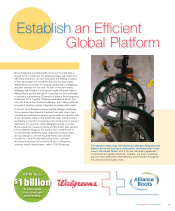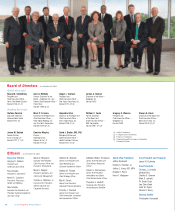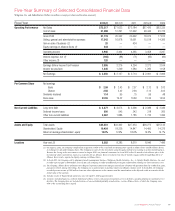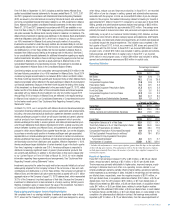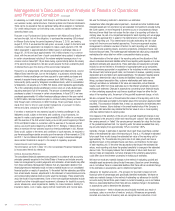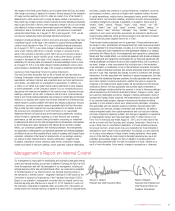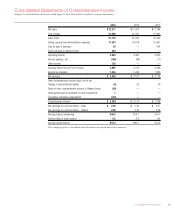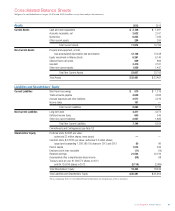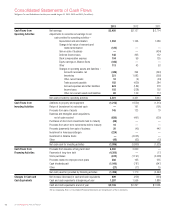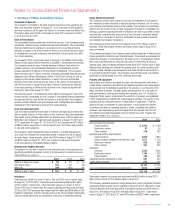Walgreens 2013 Annual Report Download - page 26
Download and view the complete annual report
Please find page 26 of the 2013 Walgreens annual report below. You can navigate through the pages in the report by either clicking on the pages listed below, or by using the keyword search tool below to find specific information within the annual report.In assessing our credit strength, both Moody’s and Standard & Poor’s consider
our business model, capital structure, financial policies and financial statements.
There can be no assurance that any particular rating will be assigned or maintained.
Our credit ratings impact our borrowing costs, access to capital markets and
operating lease costs.
Pursuant to our Purchase and Option Agreement with Alliance Boots GmbH,
we have the right, but not the obligation, to purchase the remaining 55% interest
in Alliance Boots during the period beginning February 2, 2015, and ending
August 2, 2015. If we exercise this call option, we would, subject to the terms and
conditions of such agreement, be obligated to make a cash payment of £3.133
billion (equivalent to approximately $4.9 billion based on exchange rates as of
August 31, 2013) and issue approximately 144.3 million shares of our common
stock, with the amount and form of such consideration being subject to adjustment
in certain circumstances including if the volume weighted-average price of our
common stock is below $31.18 per share during a period shortly before the closing
of the second step transaction. We also would assume the then-outstanding debt
of Alliance Boots upon the closing of the second step transaction.
Pursuant to our arrangements with AmerisourceBergen and Alliance Boots, we and
Alliance Boots have the right, but not the obligation, to purchase a minority equity
position in AmerisourceBergen over time pursuant to open market purchases and
warrants to acquire AmerisourceBergen common stock. WAB Holdings, LLC, a newly
formed entity jointly owned by Walgreens and Alliance Boots, which is consolidated
by Walgreens, can acquire up to 19,859,795 shares, which represents approximately
7% of the outstanding AmerisourceBergen common stock on a fully diluted basis,
assuming exercise in full of the warrants. The amount of permitted open market
purchases is subject to increase in certain circumstances. In fiscal 2013, we have
purchased approximately 4.0 million AmerisourceBergen shares in the open market
for $224 million. We have funded and plan to continue funding these purchases over
time through cash contributions to WAB Holdings. Share purchases may be
made from time to time in open market transactions or pursuant to instru-
ments and plans complying with Rule 10b5-1.
If we elect to exercise the two warrants issued by AmerisourceBergen in full,
Walgreens would, subject to the terms and conditions of such warrants, be
required to make a cash payment of approximately $584.4 million in connection
with the exercise of the first warrant during a six-month period beginning in March
2016 and $595.8 million in connection with the exercise of the second warrant
during a six-month period beginning in March 2017. Similarly, if Alliance Boots
elects to exercise the two warrants issued by AmerisourceBergen in full, Alliance
Boots would, subject to the terms and conditions of such warrants, be required to
pay AmerisourceBergen similar amounts upon the exercise of their warrants in 2016
and 2017. Our and Alliance Boots ability to invest in equity in AmerisourceBergen
above certain thresholds is subject to the receipt of regulatory approvals.
Commitments and Contingencies
The information set forth in Note 12 to the Consolidated Financial Statements
is incorporated herein by reference.
Critical Accounting Policies
The consolidated financial statements are prepared in accordance with accounting
principles generally accepted in the United States of America and include amounts
based on management’s prudent judgments and estimates. Actual results may differ
from these estimates. Management believes that any reasonable deviation from
those judgments and estimates would not have a material impact on our consolidated
financial position or results of operations. To the extent that the estimates used differ
from actual results, however, adjustments to the statement of comprehensive income
and corresponding balance sheet accounts would be necessary. These adjustments
would be made in future statements. Some of the more significant estimates include
goodwill and other intangible asset impairment, allowance for doubtful accounts,
vendor allowances, asset impairments, liability for closed locations, liability for
insurance claims, cost of sales, equity method investments and income taxes.
We use the following methods to determine our estimates:
Goodwill and other intangible asset impairment – Goodwill and other indefinite-lived
intangible assets are not amortized, but are evaluated for impairment annually during
the fourth quarter, or more frequently if an event occurs or circumstances change
that would more likely than not reduce the fair value of a reporting unit below its
carrying value. As part of our impairment analysis for each reporting unit, we engage
a third party appraisal firm to assist in the determination of estimated fair value
for each reporting unit. This determination includes estimating the fair value
using both the income and market approaches. The income approach requires
management to estimate a number of factors for each reporting unit, including
projected future operating results, economic projections, anticipated future cash
flows and discount rates. The market approach estimates fair value using comparable
marketplace fair value data from within a comparable industry grouping.
The determination of the fair value of the reporting units and the allocation of that
value to individual assets and liabilities within those reporting units requires us to make
significant estimates and assumptions. These estimates and assumptions primarily
include, but are not limited to: the selection of appropriate peer group companies;
control premiums appropriate for acquisitions in the industries in which we compete;
the discount rate; terminal growth rates; and forecasts of revenue, operating income,
depreciation and amortization and capital expenditures. The allocation requires several
analyses to determine fair value of assets and liabilities including, among other
things, purchased prescription files, customer relationships and trade names.
Although we believe our estimates of fair value are reasonable, actual financial
results could differ from those estimates due to the inherent uncertainty involved in
making such estimates. Changes in assumptions concerning future financial results
or other underlying assumptions could have a significant impact on either the fair
value of the reporting units, the amount of the goodwill impairment charge, or both.
We also compared the sum of the estimated fair values of the reporting units to the
Company’s total value as implied by the market value of the Company’s equity and debt
securities. This comparison indicated that, in total, our assumptions and estimates were
reasonable. However, future declines in the overall market value of the Company’s
equity and debt securities may indicate that the fair value of one or more reporting
units has declined below its carrying value.
One measure of the sensitivity of the amount of goodwill impairment charges to key
assumptions is the amount by which each reporting unit “passed” (fair value exceeds
the carrying amount) or “failed” (the carrying amount exceeds fair value) the first step
of the goodwill impairment test. Our reporting units’ fair values exceeded their carry-
ing amounts ranging from approximately 15% to more than 180%.
Generally, changes in estimates of expected future cash flows would have a similar
effect on the estimated fair value of the reporting unit. That is, a 1% change in estimated
future cash flows would change the estimated fair value of the reporting unit by
approximately 1%. The estimated long-term rate of net sales growth can have a
significant impact on the estimated future cash flows, and therefore, the fair value
of each reporting unit. Of the other key assumptions that impact the estimated fair
values, most reporting units have the greatest sensitivity to changes in the estimated
discount rate. The Company believes that its estimates of future cash flows and
discount rates are reasonable, but future changes in the underlying assumptions
could differ due to the inherent uncertainty in making such estimates.
We have not made any material changes to the method of evaluating goodwill and
intangible asset impairments during the last three years. Based on current knowledge,
we do not believe there is a reasonable likelihood that there will be a material change
in the estimates or assumptions used to determine impairment.
Allowance for doubtful accounts – The provision for bad debt is based on both
historical write-off percentages and specifically identified receivables. We have not
made any material changes to the method of estimating our allowance for doubtful
accounts during the last three years. Based on current knowledge, we do not believe
there is a reasonable likelihood that there will be a material change in the estimates
or assumptions used to determine the allowance.
Vendor allowances – Vendor allowances are principally received as a result of
purchases, sales or promotion of vendors’ products. Allowances are generally
recorded as a reduction of inventory and are recognized as a reduction of cost
Management’s Discussion and Analysis of Results of Operations
and Financial Condition (continued)
24 2013 Walgreens Annual Report



